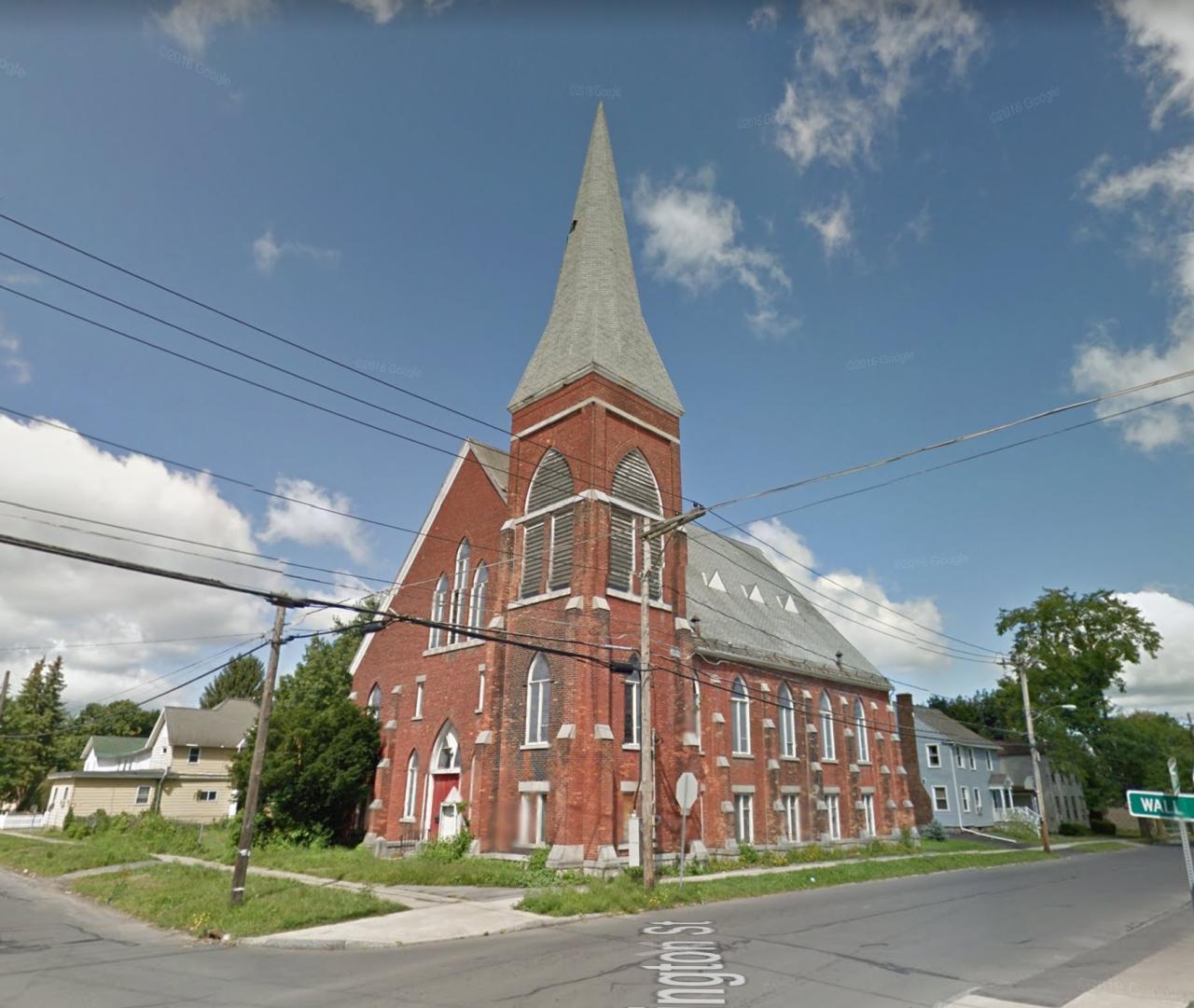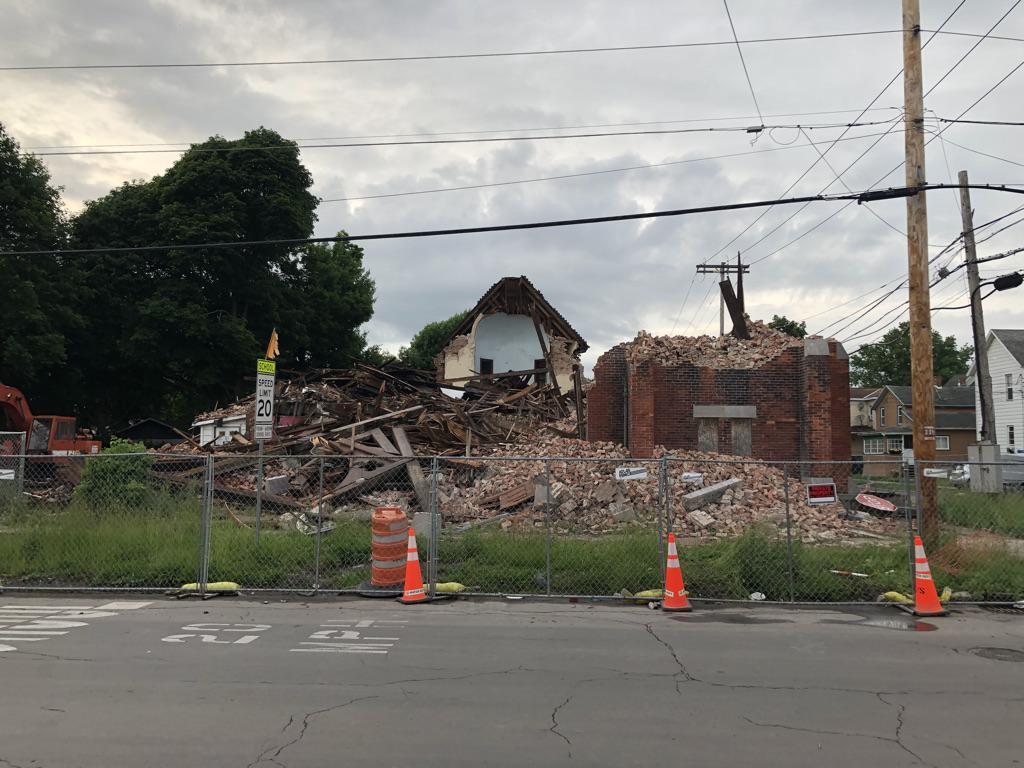The Wall Street Methodist Episcopal Church (71 Wall St Auburn, New York)

The Wall Street Methodist Episcopal Church, more recently known as the Wall Street African Methodist Episcopal Zion Church, is a late Victorian Gothic Revival church constructed in 1886 by architect Makerpeace on the northwest corner of Washington Street and Wall Street. The church served as a progressive multiracial place of worship on the north side of Auburn, NY. It was added to the National Register of Historic Places on April 29, 1999. The site occupies less than one acre on the northwest corner of Wall Street and Washington Street.
In June 2021, the City of Auburn had the Wall Street church, demolished. The National Register of Historic Places-designated building was taken down after it posed a safety issue for nearby residents. The church needed serious help for more than 20 years. The fact that the owners and the City let it get to that point was a mistake and at best, a missed opportunity.

Site Context and History
From the Second Great Revival, [a] progressive change was afoot in Auburn and the wider 'Burned Over' district. These changes in church dogma resulted in a new architectural style for churches built during this time. This new development in style was born from the increased role of Sunday school programs and the economic forces of growing non-ritual congregations during a time of rising land costs, growing congregations, and rising city populations.
Amidst the changes happening in the church, in 1854, the Reverend B.I. Ives, who oversaw the church at North and Water Streets in downtown Auburn, was given the task of founding a new mission in the northwest part of the City of Auburn by the Oneida Conference of the Methodist Church. Shortly after, the new congregation met in various buildings in northern Auburn until 1860 when a new building was constructed at the corner of Wall and Washington Streets. In the span since its opening, the congregation grew and subsequent alterations to the church were made to accommodate this growth. However, the alterations were not sufficient for the expanding congregation within the growing city. A new building was constructed at the same corner in 1886.
When it was dedicated the year after on January 13, church leaders praised the congregation for helping to raise $4,300 of the $14,000 construction cost ($128,418.82 and $418,107.79 respectively in current [as of 03/25/2022] USD with an average inflation rate of 2.55% per year) in just that morning’s service alone.
The AME Zion Church at 71 Wall Street was added to the National Register of Historic Places in 1999, however Mark A. Rodman, a student from Cornell University, prepared an Historic Structure Report stating that even in 1999, the building needed repairs. He had expressed “extreme concern” for the 1976 asphalt shingles, which needed replacing.6 He laid out three phases of repair and rehabilitation that addressed other areas of concern that “threatened the lifespan of the structure,” which totaled $302,263.69 Twenty years later in November of 2019 the firm Klepper, Hahn & Hyatt were commissioned by the City of Auburn to create a Structural Condition Review Report and they also noted significant water damage due to the unrepaired roof as well as other things that totaled $350,000.
Despite its originally stated architectural significance in the approved application for the National Register on April 29, 1999, the Wall Street Methodist Episcopal Church could have also held a historical significance relating to its association with “events that have made a significant contribution to the broad patterns of our history,” as laid out in 36 CFR §60.4 (a). Historically, during the time of its original inception at that location in 1860, the church was active in the antislavery movement. The church was known early on as a multiracial abolitionist church. Rev. William Hosmer regularly spoke there and was also the editor of the Northern Independent, an Auburn anti-slavery weekly newspaper published from 1856-186364 ‒ Hosmer’s 1840’s Greek Revival home sat a few blocks away at 29 Washington Street and is also listed on the National Register.65 Harriet Tubman ‒ an Auburn resident, abolitionist, political activist, and emancipator of at least 70 enslaved people through 13 rescue missions ‒ has ties to the church. William Henry Stewart, Jr., Tubman’s great-nephew, was married to Emma Moseby in the first church at this location in 1879 prior to its expansion in 1886.
Demolition

Next, is an accounting for the materials what went to the landfill that could have been salvaged in a deconstruction. According to
the most recent 2022 estimate, the Cornell University’s Circular Construction Lab (CCL) estimated a total of 1,170.7 tons of construction debris broken down by material: 650 tons of bricks, 0.46 tons of lamella wood, 9.28 tons of wood rafters, 28.46 tons of wood flooring and construction, 7.30 tons of asphalt roof shingles, 43.20 tons of roof construction, and 432 tons of concrete foundation. 81 It is important to note that these estimates are based on photos and publicly available information.
Robinson Roll Off, the company tasked with hauling the building material to the landfill, provided tipping fee invoices to the City that I acquired through a FOIL request. These invoices documented 292.16 tons of demolition debris that were carted off and sent 23.2 miles to the Town of Camillus Landfill, which accepted the construction and demolition debris. The landfill tipping fees were $60/ton, which extrapolates to costing the City of Auburn $17,529.60.
The City of Auburn incurred the cost of the demolition contractor O’Connell Excavation for $148,500, plus the roll off / tipping fees of $17,529.60, plus $1,000 for air monitoring from Barber Environmental, and $650 for Cayuga County Soil and water to reseed the lot for a grand total of $167,679.60. However, if you fully believe the Circular Construction Lab estimate over the amount taken down by O’Connell Excavation and reported by Robinson Roll Off, O’Connell Excavation may have saved the City $52,712.40 in landfill tipping fees by reusing the materials.
Full Text
This 'Demolishing Story' comes in the form of a graduating exit project of Master of Regional Planning, Jason Rearick. The profession report, in its entirety, can be found on the Cornell eCommons.


